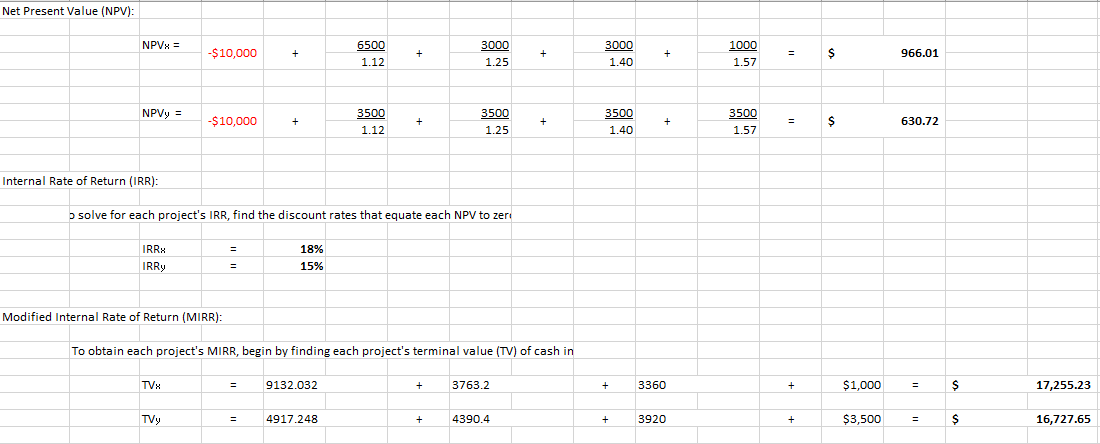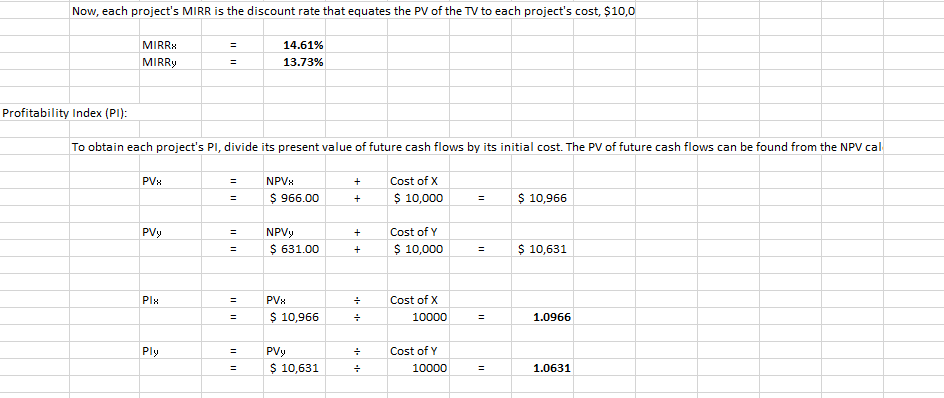Net Present Value (NPV): 3000 NPVH 6500 3000 1000 -$10,000 966.01 + + + 1.12 1.40 1.57 1.25 3500 3500 3500 NPVy 3500 -$10,000 630.72 1.57 1.12 1.25 1.40 Internal Rate of Return (IRR): o solve for each project's IRR, find the discount rates that equate each NPV to zer IRRH 18% IRRy 15% Modified Internal Rate of Return (MIRR): To obtain each project's MIRR, begin by finding each project's terminal value (TV) of cash in TV 3763.2 $1,000 9132.032 3360 17,255.23 4917.248 $3,500 TVy 4390.4 3920 16,727.65 + + Now, each project's MIRR is the discount rate that equates the PV of the TV to each project's cost, $10,0 MIRR 14.61% MIRRY 13.73% Profitability Index (PI): To obtain each project's PI, divide its present value of future cash flows by its initial cost. The PV of future cash flows can be found from the NPV cal PVH NPVx Cost of X + $ 10,966 $ 966.00 $ 10,000 + Cost of Y NPVY PVy $ 631.00 $ 10,000 $ 10,631 + Cost of X Plx PVx $10,966 10000 1.0966 Cost of Y Ply PVy $ 10,631 10000 1.0631
Net Present Value (NPV): 3000 NPVH 6500 3000 1000 -$10,000 966.01 + + + 1.12 1.40 1.57 1.25 3500 3500 3500 NPVy 3500 -$10,000 630.72 1.57 1.12 1.25 1.40 Internal Rate of Return (IRR): o solve for each project's IRR, find the discount rates that equate each NPV to zer IRRH 18% IRRy 15% Modified Internal Rate of Return (MIRR): To obtain each project's MIRR, begin by finding each project's terminal value (TV) of cash in TV 3763.2 $1,000 9132.032 3360 17,255.23 4917.248 $3,500 TVy 4390.4 3920 16,727.65 + + Now, each project's MIRR is the discount rate that equates the PV of the TV to each project's cost, $10,0 MIRR 14.61% MIRRY 13.73% Profitability Index (PI): To obtain each project's PI, divide its present value of future cash flows by its initial cost. The PV of future cash flows can be found from the NPV cal PVH NPVx Cost of X + $ 10,966 $ 966.00 $ 10,000 + Cost of Y NPVY PVy $ 631.00 $ 10,000 $ 10,631 + Cost of X Plx PVx $10,966 10000 1.0966 Cost of Y Ply PVy $ 10,631 10000 1.0631
Essentials Of Investments
11th Edition
ISBN:9781260013924
Author:Bodie, Zvi, Kane, Alex, MARCUS, Alan J.
Publisher:Bodie, Zvi, Kane, Alex, MARCUS, Alan J.
Chapter1: Investments: Background And Issues
Section: Chapter Questions
Problem 1PS
Related questions
Question
100%
You are a financial analyst for the Brittle Company. The director of capital budgeting has asked you to analyze two proposed capital investments: Projects X and Y. Each project has a cost of $10,000, and the cost of capital for each is 12%. The projects' expected net cash flows are shown in the table below.
Expected Net Cash Flows
|
Year |
Project X |
Project Y |
|
0 |
– $10,000 |
– $10,000 |
|
1 |
6,500 |
3,500 |
|
2 |
3,000 |
3,500 |
|
3 |
3,000 |
3,500 |
|
4 |
1,000 |
3,500 |
- Which project or projects should be accepted if they are independent?
- Which project or projects should be accepted if they are mutually exclusive?

Transcribed Image Text:Net Present Value (NPV):
3000
NPVH
6500
3000
1000
-$10,000
966.01
+
+
+
1.12
1.40
1.57
1.25
3500
3500
3500
NPVy
3500
-$10,000
630.72
1.57
1.12
1.25
1.40
Internal Rate of Return (IRR):
o solve for each project's IRR, find the discount rates that equate each NPV to zer
IRRH
18%
IRRy
15%
Modified Internal Rate of Return (MIRR):
To obtain each project's MIRR, begin by finding each project's terminal value (TV) of cash in
TV
3763.2
$1,000
9132.032
3360
17,255.23
4917.248
$3,500
TVy
4390.4
3920
16,727.65
+
+

Transcribed Image Text:Now, each project's MIRR is the discount rate that equates the PV of the TV to each project's cost, $10,0
MIRR
14.61%
MIRRY
13.73%
Profitability Index (PI):
To obtain each project's PI, divide its present value of future cash flows by its initial cost. The PV of future cash flows can be found from the NPV cal
PVH
NPVx
Cost of X
+
$ 10,966
$ 966.00
$ 10,000
+
Cost of Y
NPVY
PVy
$ 631.00
$ 10,000
$ 10,631
+
Cost of X
Plx
PVx
$10,966
10000
1.0966
Cost of Y
Ply
PVy
$ 10,631
10000
1.0631
Expert Solution
This question has been solved!
Explore an expertly crafted, step-by-step solution for a thorough understanding of key concepts.
This is a popular solution!
Trending now
This is a popular solution!
Step by step
Solved in 2 steps

Knowledge Booster
Learn more about
Need a deep-dive on the concept behind this application? Look no further. Learn more about this topic, finance and related others by exploring similar questions and additional content below.Recommended textbooks for you

Essentials Of Investments
Finance
ISBN:
9781260013924
Author:
Bodie, Zvi, Kane, Alex, MARCUS, Alan J.
Publisher:
Mcgraw-hill Education,



Essentials Of Investments
Finance
ISBN:
9781260013924
Author:
Bodie, Zvi, Kane, Alex, MARCUS, Alan J.
Publisher:
Mcgraw-hill Education,



Foundations Of Finance
Finance
ISBN:
9780134897264
Author:
KEOWN, Arthur J., Martin, John D., PETTY, J. William
Publisher:
Pearson,

Fundamentals of Financial Management (MindTap Cou…
Finance
ISBN:
9781337395250
Author:
Eugene F. Brigham, Joel F. Houston
Publisher:
Cengage Learning

Corporate Finance (The Mcgraw-hill/Irwin Series i…
Finance
ISBN:
9780077861759
Author:
Stephen A. Ross Franco Modigliani Professor of Financial Economics Professor, Randolph W Westerfield Robert R. Dockson Deans Chair in Bus. Admin., Jeffrey Jaffe, Bradford D Jordan Professor
Publisher:
McGraw-Hill Education